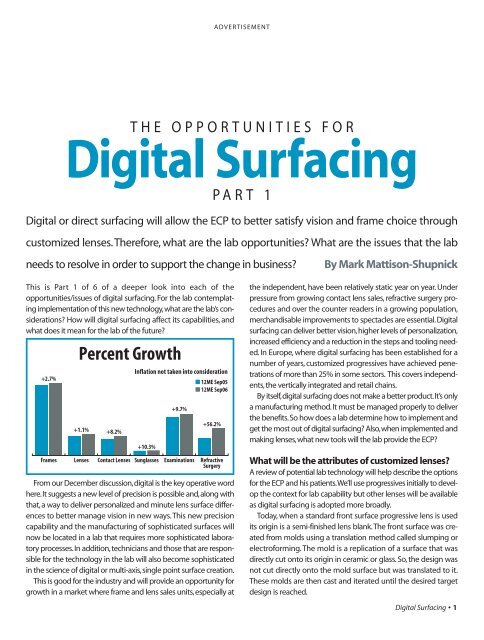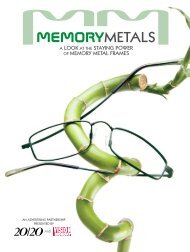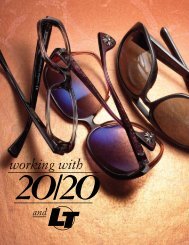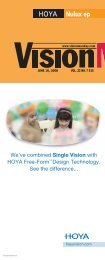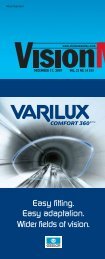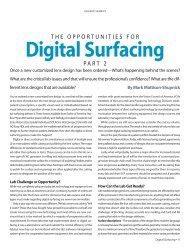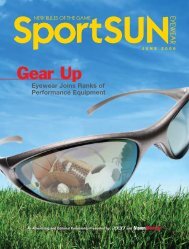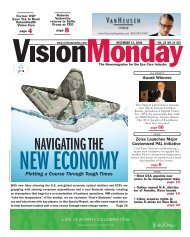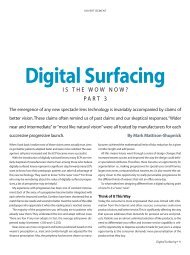The Opportunities For Digital Surfacing - Part 1
The Opportunities For Digital Surfacing - Part 1
The Opportunities For Digital Surfacing - Part 1
You also want an ePaper? Increase the reach of your titles
YUMPU automatically turns print PDFs into web optimized ePapers that Google loves.
ADVERTISEMENT<br />
THE OPPORTUNITIES FOR<br />
<strong>Digital</strong> <strong>Surfacing</strong><br />
PART 1<br />
<strong>Digital</strong> or direct surfacing will allow the ECP to better satisfy vision and frame choice through<br />
customized lenses. <strong>The</strong>refore, what are the lab opportunities? What are the issues that the lab<br />
needs to resolve in order to support the change in business?<br />
By Mark Mattison-Shupnick<br />
This is <strong>Part</strong> 1 of 6 of a deeper look into each of the<br />
opportunities/issues of digital surfacing. <strong>For</strong> the lab contemplating<br />
implementation of this new technology,what are the lab’s considerations?<br />
How will digital surfacing affect its capabilities, and<br />
what does it mean for the lab of the future?<br />
+2.7%<br />
Percent Growth<br />
+1.1% +8.2%<br />
Inflation not taken into consideration<br />
+10.3%<br />
+9.7%<br />
■ 12ME Sep05<br />
■ 12ME Sep06<br />
+56.2%<br />
Frames Lenses Contact Lenses Sunglasses Examinations Refractive<br />
Surgery<br />
From our December discussion,digital is the key operative word<br />
here.It suggests a new level of precision is possible and,along with<br />
that, a way to deliver personalized and minute lens surface differences<br />
to better manage vision in new ways. This new precision<br />
capability and the manufacturing of sophisticated surfaces will<br />
now be located in a lab that requires more sophisticated laboratory<br />
processes.In addition, technicians and those that are responsible<br />
for the technology in the lab will also become sophisticated<br />
in the science of digital or multi-axis,single point surface creation.<br />
This is good for the industry and will provide an opportunity for<br />
growth in a market where frame and lens sales units, especially at<br />
the independent, have been relatively static year on year. Under<br />
pressure from growing contact lens sales, refractive surgery procedures<br />
and over the counter readers in a growing population,<br />
merchandisable improvements to spectacles are essential. <strong>Digital</strong><br />
surfacing can deliver better vision,higher levels of personalization,<br />
increased efficiency and a reduction in the steps and tooling needed.<br />
In Europe, where digital surfacing has been established for a<br />
number of years, customized progressives have achieved penetrations<br />
of more than 25% in some sectors. This covers independents,<br />
the vertically integrated and retail chains.<br />
By itself,digital surfacing does not make a better product.It’s only<br />
a manufacturing method. It must be managed properly to deliver<br />
the benefits.So how does a lab determine how to implement and<br />
get the most out of digital surfacing? Also,when implemented and<br />
making lenses,what new tools will the lab provide the ECP?<br />
What will be the attributes of customized lenses?<br />
A review of potential lab technology will help describe the options<br />
for the ECP and his patients.We’ll use progressives initially to develop<br />
the context for lab capability but other lenses will be available<br />
as digital surfacing is adopted more broadly.<br />
Today, when a standard front surface progressive lens is used<br />
its origin is a semi-finished lens blank. <strong>The</strong> front surface was created<br />
from molds using a translation method called slumping or<br />
electroforming. <strong>The</strong> mold is a replication of a surface that was<br />
directly cut onto its origin in ceramic or glass. So, the design was<br />
not cut directly onto the mold surface but was translated to it.<br />
<strong>The</strong>se molds are then cast and iterated until the desired target<br />
design is reached.<br />
<strong>Digital</strong> <strong>Surfacing</strong> •1
ADVERTISEMENT<br />
<strong>Digital</strong> surfacing allows the direct surfacing of molds and/or<br />
lenses.No translation per se is required.Of course,the cut surface is<br />
tested to be sure that it is the intended design. In addition, there<br />
is control of the cutting axes other than a base and cross curve so<br />
surfaces that can be described in multiple axes can be cut directly<br />
and cast or molded to produce SF progressives. Finally, lenses can<br />
also be digitally surfaced directly to produce progressive or other<br />
sophisticated surfaces.<br />
Dr. Mike Morris of Carl Zeiss Vision believes that progressives<br />
in the future will be divided into two types: fixed designs and<br />
customized designs.<br />
Fixed designs have preset characteristics such as size of<br />
viewing zones and corridor length that are consistent for all<br />
patients, and only the prescription powers are varied. While<br />
these can be delivered via digital surfacing to achieve the<br />
greatest possible clarity of vision, they cannot be considered<br />
designed for individual needs.<br />
Customized designs are created at the time of production<br />
based on specific wearer needs and the position of wear of the<br />
lenses. This means that several variables will be required to<br />
produce a customized progressive lens.<strong>The</strong>se variables include<br />
the way in which lens power is distributed between the front<br />
and back surface, the specific fitting characteristics of the<br />
frame and how the patient will use the spectacles.<br />
This is something we all need to prepare for, because the<br />
prescription may be the same, but the lens that delivers the<br />
prescription will be different in entirely new ways.<br />
Customization will alter the lens design with patient information<br />
other than the prescription, PD and fitting height. It will deliver<br />
some or all of the following: powers compensated for lens tilt, vertex<br />
distance and wrap angle.<strong>The</strong> peripheral characteristics can be<br />
optimized for position of wear, corridor length and viewing zone<br />
size. Front surface progressives can be further optimized by specially<br />
cutting the back surface to reduce unwanted errors in the<br />
periphery away from the corridor. Peripheral design will be modified<br />
based on the frame chosen and fitting height needed. Reading<br />
distance or multiple corridor lengths can be specified. Others<br />
will add design changes for daily tasks i.e.,the estimated percent of<br />
time spent driving,working at a computer,walking,sitting,etc.Finally,others<br />
will incorporate measurements of how the eyes and head<br />
move when reading or using other areas in the lens.<br />
Which prescriptions will benefit from which of these customizations?<br />
How much will they cost? How long will they take to get?<br />
What tools will the ECP need to actually order lenses with these<br />
attributes? First,if the lab will deliver this,what are they asking? Let’s<br />
take a first look at some lab questions.<br />
Lenses Cut Using Single Point Diamond Turning<br />
How does single point<br />
diamond turning deliver<br />
the ability to improve<br />
and customize progressive<br />
lens surfaces? It is the<br />
spinning of a mold or<br />
lens against a single point<br />
cutter while moving the<br />
lens closer and farther<br />
from the cutter. This<br />
results in a series of<br />
joined surface heights<br />
that deliver a specific progressive<br />
design.<br />
<strong>For</strong> Varilux Physio, the<br />
design is cut and polished<br />
on a mold’s back surface.Lenses are then cast and the accuracy<br />
of production of the design is verified. Any changes that are<br />
necessary are made to the software that controls the cutting operation.<br />
Testing determines how many software changes are<br />
required until the design is right.Wearer testing also confirms the<br />
design required.<br />
<strong>For</strong> a lens like Zeiss Gradal Individual, the design is cut directly<br />
onto the back surface of a single vision lens blank. Regardless of<br />
front or back, designs are verified to know that they deliver the<br />
vision clarity intended.<br />
More about design differences in the next issue.<br />
Labs Are Considering…<br />
If lenses can now be directly surfaced with digital control, then<br />
where can I get them?<br />
Currently, a variety of customized designs, each with different<br />
attributes,are available from Essilor of America (Varilux Physio360,<br />
Varilux Ipseo, Definity, Definity short and Accolade Freedom) and<br />
Carl Zeiss Vision (SOLAOne HD, Zeiss Gradal Individual). HOYA,<br />
Shamir,Signet Armorlite and SEIKO each have a design with some<br />
customization available.<br />
Optical lab owners are asking themselves whether now is the right<br />
2• <strong>Digital</strong> <strong>Surfacing</strong>
ADVERTISEMENT<br />
time to be capable of digitally surfacing lenses? <strong>The</strong> considerations<br />
are many. 1.<strong>The</strong> equipment is new in the US and will cost the lab<br />
upwards of $500,000.2.<strong>The</strong> demand for customized lenses is already<br />
about 4% of the PAL market and ECP awareness is growing rapidly<br />
so there is a reasonable opportunity to amortize the cost of the<br />
equipment.3.Depending on the level of customization,the software<br />
requirements can vary greatly.Labs typically do not develop software<br />
but rely on others for their lab management systems,financial analysis,billing<br />
software,etc.4.<strong>The</strong> manufacturing responsibility becomes<br />
the lab’s if the lab is creating a progressive design.5.<strong>The</strong>refore,the lab<br />
must have the ability to engrave and verify that they’ve created the<br />
intended design. 6. Can I get the variety of designs that now meet<br />
the needs of my customers? And 7. How hard is it to cut and polish<br />
and deliver the right design? Overall this manufacturing technology<br />
is still relatively new in the US and we can expect continued changes<br />
to design and equipment to produce these high precision designs.<br />
Lens Blanks<br />
Depending on the design attributes of the final product, labs will<br />
start with a SF progressive or single vision lens blank. SF progressives<br />
designs, from molds digitally created, are manufacturer warranted.If<br />
further back surface optimized,alignment while processing<br />
is critical.<strong>For</strong> SV blanks where the progressive is placed on the<br />
back surface, alignment may be determined by semi-visible<br />
engravings on the SV front or added after by analyzing the position<br />
of the design in the lens.<br />
Generators and Polishers<br />
<strong>The</strong>se generators single point turn the lens surface.<strong>The</strong> accuracy<br />
and precision is dependent<br />
on how fast the height<br />
changes can be made (slew<br />
rate) while the lens surface is<br />
being turned.In addition,the<br />
speed that the data can be<br />
delivered to ensure cutter<br />
position is critical to achieve<br />
the desired surface.<br />
In both cases,there are still<br />
situations where the design cannot be achieved because it<br />
requires capabilities that exceed those of the generator. This is<br />
especially true of designs that have stronger characteristics such<br />
as high powers, very short corridors or rapid transitions between<br />
viewing zones.<br />
COURTESY OF SCHNEIDER OPTICAL MACHINES<br />
COURTESY OF KEPETS<br />
SYSTEMTECHNIK<br />
<strong>The</strong> process, sometimes called “Cut and Buff”prepares the surface<br />
and then buffs for transparency.Traditional polishing would<br />
destroy a progressive lens design, so great care has been taken<br />
with digital surfacing and polishing systems. Most generators<br />
have a second and sometimes a third cutter so that a very fine<br />
surface can be cut. This significantly reduces the amount of polishing<br />
that must be done to get a glossy surface, but the polishing<br />
or buffing process still limits the precision of design production.<br />
<strong>The</strong> best systems are carefully optimized to the specific<br />
design being produced, adjusting several variables such as pressures,<br />
tool shape and dwell time to achieve the highest precision<br />
of design reproduction.<br />
<strong>The</strong>refore, polishing has<br />
been more difficult to master<br />
than cutting. In this case, it’s<br />
really a high luster buffing that<br />
the surface gets to improve<br />
transparency.Multiple tool radii<br />
are required with the lens position<br />
controlled for the location<br />
of the varying surface heights.<br />
Semi-Visible Engravings<br />
Since the lab has created or optimized the<br />
surface, the lens may need semi-visible<br />
engravings added to assist in power verification,<br />
edging layout and fitting. <strong>The</strong>refore,<br />
each digital surfacing module will have a CO 2<br />
or Excimer laser in line with the system.Lenses<br />
are aligned and engraved with any variety of information<br />
including personalization,the patient’s initials or the invoice number<br />
so the lenses can be identified.<br />
Did I Make What Was Ordered?<br />
Finally, verification of the order is required and that is accomplished<br />
using a mapping device that measures the through power<br />
of the actual lens,creates a lens map of the power distribution and<br />
compares that map to the intended design.<strong>The</strong> software program<br />
calculates the differences and the lens is a go or no go.<br />
Who’s <strong>The</strong> Manufacturer?<br />
Unlike manufacturer-supplied SF progressives, where the design<br />
is manufacturer warranted, digitally surfaced lenses from the lab<br />
must also come with the lab’s warranty of design performance.<br />
<strong>Digital</strong> <strong>Surfacing</strong> •3
ADVERTISEMENT<br />
<strong>The</strong>refore, each lens design a lab<br />
offers will require that the lab have<br />
in place new metrology i.e., the<br />
methods for analysis and verification<br />
as well as internal certifications from the original design manufacturer.We<br />
can therefore expect that labs will implement more<br />
automation for mapping and marking lenses.<strong>The</strong>y’ll also use more<br />
robotics to move the lenses from one station to another with precision<br />
and accuracy.<br />
So each laboratory is asking questions about customized lenses<br />
and the methods to supply them.This is especially important for<br />
labs that have existing equipment that needs replacing.To meet<br />
this need and to address the fact that customized progressives are<br />
still in limited use but growing,new models of generators and polishers<br />
capable of digital surfacing are also useful for standard<br />
spheres and toric lens surfaces. <strong>The</strong>refore, with more versatile<br />
equipment on the laboratory floor,labs will be ready to implement<br />
customized progressives with the assistance of the lens manufacturers.Like<br />
the Crizal Alize and Teflon AR technology transfers,we’ll<br />
see digital surfacing technology transfers with progressive lens<br />
design licenses and the software needed to create those designs<br />
accurately.<br />
Spheres will become aspheres,toric surfaces will become atoric<br />
and the fields of clear view for the patient will increase for better<br />
patient satisfaction. Fixed design progressives will be further<br />
improved by cutting an optimizing surface on the back.In combination,<br />
the periphery becomes clearer since unwanted astigmatism<br />
is reduced.<br />
How can the ECP know that the customization ordered is the<br />
customization received? <strong>The</strong> ECP must trust their lab since the verification<br />
of design is the lab’s responsibility to them and the company<br />
that they received the design capability from.<br />
Technology does not stand still and as the designs improve so<br />
will AR and hard coats to further enhance the improvements<br />
made to the design.In both cases,the more merchandisable benefits<br />
that we can bring to wearers, the better. Patients also understand<br />
that new technologies cost more.<br />
What Should the ECP Do Now?<br />
Begin by reading the ads and articles in the trade journals.Request<br />
lens and lab representatives to visit and detail their digitally surfaced<br />
Unlike manufacturer-supplied<br />
SF progressives, where the design<br />
is manufacturer warranted,<br />
digitally surfaced lenses from<br />
the lab must also come with the lab’s<br />
warranty of design performance.<br />
Sponsored by<br />
lenses, attributes and benefits.<br />
Understand their methods and tools<br />
that show that correct customization<br />
was received.Request literature.<br />
Experiment by trying them yourself or on a staff member.Determine<br />
the comparisons and the goals for the test. Extend the trial<br />
to patients quickly for a variety of responses to best determine the<br />
positioning of each of the products within your own brand.<br />
<strong>The</strong>n develop a Plan of Action to include customized progressives<br />
in your practice. Set goals; educate all about their role in<br />
teaching patients about the opportunity and what they will do for<br />
them. Encourage staff to be adventurous, discuss successes and<br />
issues at staff meetings so that customized progressives become a<br />
seamless addition to the practice. Finally, measure your success<br />
using reports from practice management software, request an<br />
analysis of purchases with historical data from your lab and determine<br />
things to work on for continuous improvement.<br />
Next Issue<br />
• What are the different digitally surfaced products?<br />
• Which patients are the right targets, and how do you talk to<br />
them?<br />
• Answers to questions received from readers.<br />
New in the Market Since Last Article<br />
New research teaches that the myope has a longer eye than the<br />
hyperope,the retina is also steeper and therefore,the way that the<br />
power is distributed on the lens surface affects the way that the<br />
patient comfortably uses the lens.<br />
New Harmonix Technology from Essilor considers the differences<br />
in eye shape and the Accolade lens design automatically meets<br />
each patient’s physiological needs.<strong>Digital</strong> surfacing can also free the<br />
optician from some of the limitations of “minimum fitting height”<br />
requirements.<strong>The</strong> design of the progressive is adjusted for the frame<br />
size chosen,fitting height required,prescription and what is known<br />
about the visual characteristics of wearer.In new Accolade Freedom,<br />
eye and frame shape are considered when the prescription is created.<strong>The</strong><br />
design is changed to improve distance area in large frames<br />
and shorten the corridor in smaller frames,all automatically.<br />
Questions or comments? Let me know at mmshupnick@jobson.com


